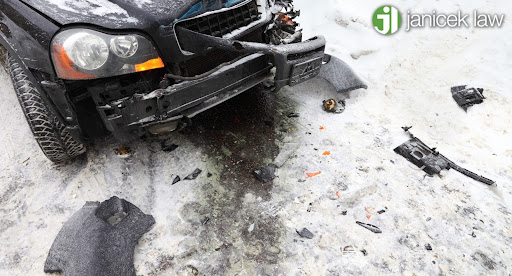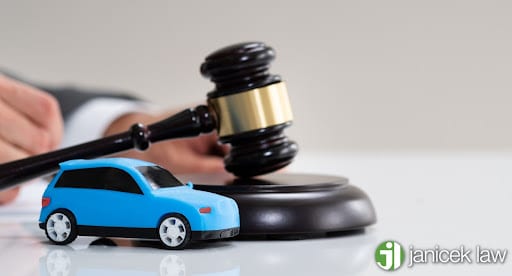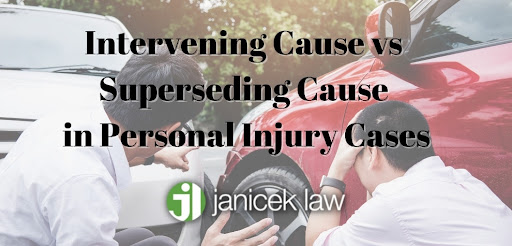Accidents are complicated events. And when an accident involves injured parties, multiple factors may complicate matters further. When injured victims need compensation for the costs associated with their injury caused by a third party, many times, they must file a personal injury lawsuit. In order to move forward with their claim, they must prove that another party was at fault for their injury.
In order to prove fault, the injured party must first establish the element of negligence. Part of establishing negligence requires showing that the at-fault party’s action or inaction was a cause of the injures.
Both intervening and superseding causes can blur the lines for those trying to establish fault in their personal injury cases. In some cases, these causes can diminish or erase the defendant’s liability.
This means that for personal injury victims, intervening and superseding causes can reduce or eliminate the ability to receive adequate damages for the injuries sustained.
Liability in a personal injury case hinges on proving a defendant’s negligent action connects directly to the accident or event. When faced with this situation, you need the guidance and experience of a San Antonio personal injury attorney at Janicek Law.
Proximate Cause, Intervening Cause, and Superceding Cause in Third-Party Accidents
Any time a third party is introduced in a scenario, things get more complicated. This is exacerbated when an accident occurs. Accidents such as car wrecks, slip or trip and falls, incidents on construction sites, and more are examples of personal injuries typically caused by a third party.
The notion of proximate, intervening, and superseding causes creates a grey area, making it more difficult for victims to receive fair compensation for their injuries sustained as a result of the at-fault party’s negligence.
What are these causes, and how do they affect personal injury claims?

What Is a Proximate Cause?
In personal injury cases, the proximate cause is simply the legal cause of the accident.
When actions of the liable party happen in an unbroken chain of events and directly cause injuries, they are the proximate cause of the accident.
The claimant must prove that the proximate cause of the accident and the injuries that occurred as a result of the accident wouldn’t have occurred, if not for the defendant’s negligence.
Proving the following two elements establish proximate cause in a personal injury claim:
Cause in Fact
Cause-in-fact is the link between the at-fault party’s actions and the damages sustained by the injured party. The injury exists because of the actions performed (or not performed) by the negligent party.
Legal Causation
The element of legal causation is the cause that created the series of events that led to the accident. If not for the cause, the accident would not have happened. Whether the chain of events could be foreseen and whether the defendant owed a duty of care to the injured party also play a role in determining the at-fault party’s responsibility.
Cases that involve multiple proximate causes become increasingly more complex.
What Is an Intervening Cause?
Any act that breaks the direct link between the defendant’s actions and the victim’s injuries, after the negligent action, is an intervening cause.
An intervening cause can either be a third party’s action or an act of nature.
If a car accident eyewitness tries to help a victim but instead, worsens the injuries, this is an example of an intervening cause. Another example could be a tree branch falling in the midst of the accident.
So, unlike proximate cause, an intervening cause could potentially lessen or remove a defendant’s liability. However, in both cases, the original defendant is typically considered partially liable for the damages, even when an intervening cause is present. The defendant is relieved of their liability only if the event was not foreseeable to a reasonable person.

Types of Intervening Causes
Two types of intervening causes exist. These are dependent and independent.
Dependent Intervening Cause
The dependent intervening cause stems from the defendant’s behavior. Unless it is extraordinary, the defendant’s liability remains.
Independent Intervening Cause
A defendant bears no fault for an independent intervening cause. Unless the event was foreseeable, it relieves the defendant of liability.
What Is a Superseding Cause?
A superseding cause prevents a claimant from establishing a proximate cause in an accident. It overrides or supersedes a defendant’s accident liability. It serves as a powerful defense against claims of negligence. That’s because superseding cause proves that something or someone else – not the defendant’s actions – served as the accident’s proximate cause.
Often a defendant may avoid liability when a superseding cause exists. It weakens the connection between the claimant’s injuries and the defendant’s actions.
A superseding cause is also one that cannot be foreseen. An example of a superseding cause is if a product manufacturer includes appropriate warnings on its packaging that a retailer later removes. The retailer’s actions are a superseding cause if a consumer receives an injury. The product manufacturer may be protected from liability.
What is the Difference Between Intervening Cause and Superseding Cause?
Foreseeability is the primary difference between intervening cause and superseding cause. This is a personal injury concept that attorneys use to determine what caused an accident. Foreseeability measures whether or not a reasonable person should have foreseen the consequences of the negligent person’s actions.
An intervening act becomes a superseding cause that removes a defendant’s liability if and only if the action should have been foreseeable to the defendant.

Foreseeability and Proximate Cause
The scope of liability is usually based on the foreseeability of the method and type of harm. The amount of damage caused does not restrict it.
Unforeseeable Type of Harm
If the harm doesn’t foreseeably stem from negligent behavior, then the third party is not liable for the plaintiff’s injury.
Unforeseeable Manner of Harm
If the superseding cause was unforeseeable, then the injured party cannot hold the person who caused the injury responsible for the injury. This is because the superseding act breaks the direct link between the damage and the action that caused it. When this happens, the at-fault person is often relieved of responsibility.
Examples of unforeseeable superseding causes include but are not limited to:
- Hurricanes, earthquakes, and other acts of God
- Third-party torts and criminal acts such as burglary or attacks or injuries that occur on another’s property
Examples of foreseeable superseding causes include (the defendant does not escape liability):
- Harm inflicted by rescuers such as firefighters, medical personnel, and others who provide aid
- Ordinary negligence by healthcare workers
- Further injury or disease that occurs because of the injured party’s diminished condition
Unforeseeable Extent of Harm
Whether the harm is predictable or not, a person who causes injury to another is liable to the full extent.
The “Eggshell Skull” Rule
The premise of the “Eggshell Skull” rule is that a reasonable person would take any injuries the victim sustained at face value, without diving into the specifics of what may or may not have happened if the injured victim didn’t have a preexisting condition.
Take, for instance, an accident that would cause a few thousand dollars in damage under ordinary circumstances, but the injured person has a rare condition that compounds the injuries. Due to the additional factor of the victim’s existing health condition, they now need $125,000 in medical care for their accident injuries. The negligent actor is held liable for the total amount of the victim’s injuries.
The Eggshell Rule protects victims who aren’t at fault for their condition. Defendants must take full responsibility for the injuries they’ve caused, regardless if the cost would differ if the victim didn’t have preexisting conditions that exacerbated the injury.
Superseding and Intervening Causes in Injury Cases
In the average personal injury case, the “but-for test” may be used to determine causation for the damages a victim suffered. The test questions whether or not the victim would have sustained the injuries had it not been for the negligent actions or inaction.
If the answer is “no,” then the defendant is responsible for the victim’s injuries.
Any intervening or superseding causes are considered when determining liability. While the presence of an intervening cause probably won’t remove the defendant’s liability for the plaintiff’s injuries, they may share the liability with the party responsible for the intervening cause.
A case with a superseding cause may provide a defendant with full protection from liability. A claimant may be forced to file a claim against the party that caused the superseding act if this happens.
Also, injury victims might not be able to file a personal injury case if the superseding cause was an act of God.
Can You File a Personal Injury Claim?
Injury victims must prove negligence in order to have a viable personal injury case. This involves establishing a proximate cause. Only once the personal injury attorney establishes proximate cause, may the injured file a personal injury claim. Injured victims may file a personal injury suit against multiple parties.
As mentioned, if a superseding event exists and holds enough merit, victims may be able to file a claim against the party responsible for the event.
Personal injury claims can become complicated quickly, so we encourage those who wish to file a claim to obtain competent legal counsel as quickly as possible. The skilled attorneys at Janicek Law are well-versed in intervening or superseding cause. They’ll explore the legal options in a free consultation and devise the best strategy for a successful outcome.

Experienced San Antonio Personal Injury Lawyers Can Help
The San Antonio personal injury lawyers at Janicek Law have extensive experience with superseding cause torts. Ensuring our clients receive full and fair compensation for injuries they sustain due to another person’s negligence or third person is always our goal.
We thoroughly investigate the legal cause of your critical issue and have the knowledge and skill necessary to present a strong case to a jury and win. Call the super lawyers at Janicek Law for a free consultation about your superseding intervening cause case today. Our phone number is (210) 366-4949.
Our firm also handles various legal issues, including San Antonio 18-wheeler accidents, premises liability, San Antonio nursing home abuse, car accident injuries, and more.
Establish your attorney-client relationship with our law firm by calling to set up a free consultation today.

